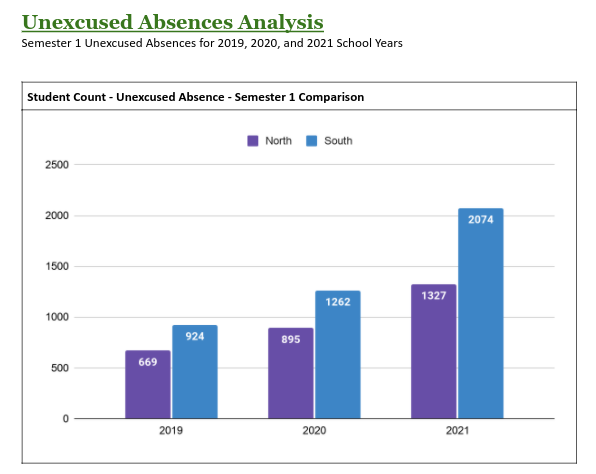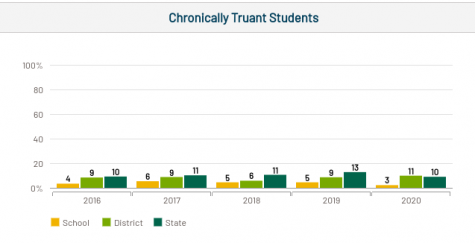On the decline: attendance, grades, motivation, focus
January 29, 2021

Data provided by Kelly Zuerner
WIDENING THE GAP: The difference in unexcused absences have been historic between DGN and DGS mostly due to the difference in student population (2,159: 2,730 as of 2020), but as both schools see an increase in student absences, the gap grows larger.
“There are more students struggling in the remote environment than ever before,” Counseling and Student Support Services (CSSS) chairperson David King said.
Even with the opportunity to return to school following the hybrid schedule, there are still a large number of students in the district choosing to stay remote. According to Associate Superintendent Gina Ziccardi, as of Jan. 25, 31.3% of the student body at DGN opted for remote learning as well as 48.4% at DGS.
Now, due to the conclusion of the first semester, data and the results of the pandemic and its effect on schooling are finally available.
Wavering attendance
The District 99 Board of Education (BOE) released data at the Dec. 14 meeting about the 2020 School Report Card, highlighting attendance rates seen in the spring of 2020. It indicates that the data may be inaccurate due to the COVID-19 virus.
Especially since “attendance” last spring was taken through submitting a Google form each day, students could have forgotten to submit or replied “yes” even if they did not do their work that day.
Still, with online Zoom classes, data on attendance can be skewed by what teachers actually consider “in class.”
“[Attendance] has been a level of concern, but it’s inconsistent because I’m sure some teachers say ‘cameras on’ and some are okay with cameras off,” King said.
According to data gathered in the first semester of the 2020-2021 school year, the number of unexcused absences at DGN has risen 48.3% since last year, while at DGS it has increased by 64.3%.
“[Attendance] has always been a concern for the district. We’ve done some things over the years to try to increase student attendance, or minimize truancy,” Ziccardi said. “It is always going to be harder when you’re remote because you can send emails and make calls but you can’t just go and grab them out of class.”
The district has taken some initiatives to hold students accountable for missing classes.

“Our deans are calling home and connecting with students. Throughout the semester we were doing home visits because [some students] were not responding,” Ziccardi said.
Although both schools face an increase in unexcused absences, chronic absenteeism, and chronic truancy, DGS has consistently held higher rates.
“That has historically been the case—I account for some of that to be greater mobility at DGS. ‘Mobility’ meaning students that come and go. We also have higher rates on low-income students and a greater population,” Ziccardi said.
There are many other factors that could lead to higher rates of absenteeism and truancy at both schools in District 99, including student performance and motivation. The BOE has been working on assisting more students academically through new programs like “Paper” and reminding them of other outlets to receive help.
“I know we’ve provided more academic support so hopefully as students are more engaged academically, attendance will improve. If you’re doing well, you probably feel a lot better about being in school,” Ziccardi said.
E-learning: helping or hurting?
Although it’s too early to gather and analyze data on the first half of the 2020-2021 school year, the general consensus for teachers is that of discontent.
At the conclusion of the first semester, many students accredit their decrease in academic success to the remote learning environment.
“This year, my grades have not been where I want in comparison to previous years. Motivation is a piece of it. But, I’m pretty easily distracted. Forms of distraction come a lot easier being online,” junior Quinn Slattery said.
Other students have flourished in the online environment, yet they know that the quality of the content retention is less than in previous years.
“I definitely do not think my grades would be where they are at without remote learning. Pretty much all of my classes have open-note quizzes and some of the materials that we would have learned during a normal year were cut,” senior Victoria Sanchez said.
King agrees that less learning is happening with the reduced amount of class time and lack of student-teacher engagement.
“Lack of learning is there, we know it’s there, and it’s not just a North problem; it’s across the state, it’s across the country,” King said.
Motivation, or lack thereof
For some, motivation has been a large obstacle in the world of remote learning. Distractions during classes, negative emotions towards learning, and lack of results in the classroom continue to impact students’ learning.
“It’s easy to just turn off your camera, mute yourself, and find other ways to entertain yourself,” Slattery said.
Teachers make an effort to understand the position that students often find themselves in. English teacher Brittni Mitchell can sympathize with the disconnect between students and school.
“There was a trend we were seeing before we shut down in March, and it has only increased since,” Mitchell said. “Motivation and ability to focus on learning while not feeling that you are in school is quite difficult, and I recognize that even as a teacher.”
Mitchell fears that online learning will continue contributing to the decrease in student accountability and motivation in completing assignments.
“Students are now given a Z4 for missing work, but even with that ‘gift’ students still have to be intrinsically motivated to make positive decisions that lead them to academic success,” Mitchell said.
For senior Cole Cook, his motivation has not wavered since the beginning of remote learning. In fact, he admits that he never really had any to begin with.
“My motivation has never been too good. It’s never been bad. But still, not good. I’ve just always kind of done well in school and wanted to keep that up, but there’s nothing specific I’m striving for. I don’t care about my GPA, I don’t care about my transcript looking nice for colleges, I just do it for myself,” Cook said.
Being intrinsically motivated is a large advantage to students navigating the remote learning environment.
“This is indeed a team effort, but the team cannot do much if a student is not meeting us partway,” Mitchell said.
School psychologist Angela McAndrews can attest to the mental and emotional obstacles both students and faculty face in the remote environment.
“We often tell ourselves there is something wrong with us when we have negative feelings instead of recognizing [we] are human. You are not alone, but how would you know that if you don’t talk about it?” McAndrews said.
Lack of relationships
Many students and teachers have realized the disconnect between one another through online learning. There has been more difficulty developing relationships through muted microphones and black screens.
“This is not why we got into education. We got into education for [the students], and [the students] are so far away,” King said.
Along with students being physically far away through remote learning, school social workers and counselors are finding them to be more socially and emotionally distant as well.
“By the time students have found the energy to sit through several 80-minute Zoom classes, it is very difficult for us Counseling and Student Support Services Department to make connections with students in the same way we did before,” McAndrews said.
King admits this is not the ideal situation for students, teachers, and parents alike.
“The goal for the rest of the year is to develop community again,” Kings said.
Early-onset “senioritis”
It’s not uncommon for seniors to experience a lack of focus and eagerness to leave the institution they’ve called “high school” after returning from Spring Break. But with no Friday night football games, Senior Assassin, or even a last Homecoming, some are catching “senioritis” earlier than usual.
“The only thing that was keeping me going for the past few months was finishing college apps. God, that was a struggle. Now that all of that is done and [winter] break is over, all that’s left for me to do is sit and wait for responses, so yeah senioritis is really hitting,” Cook said.
A typical Prom and graduation are still in question due to the ongoing pandemic and with all the uncertainty comes the absence of hope.
Even with the end of high school on the horizon, some seniors struggle to stay motivated through an unprecedented final year.
“I realize that I have to keep up my grades in order to keep my acceptance from colleges, but at the same time finding the willpower to finish one more assignment on the computer is so mentally exhausting. Without having some sort of structure in my life or a routine like I used to, it’s very easy for me to push everything to the side and complete later,” Sanchez said.
It’s officially the beginning of the end for the class of 2021.
“I’m really just wanting to have fun for this last semester. Gotta enjoy the very little bit of high school we have left,” Cook said.
Takeaways
Learning online has affected everyone differently, but McAndrews reminds us that everyone is impacted by the pandemic and it’s normal to feel strong emotions.
“This is a big learning curve and we have to allow ourselves to be okay with our best effort even though we might not get the same results we got while in person,” McAndrews said. “In times like this it is so easy and [in] human nature to focus on the negative. And when we do, that’s all our brain wants to see: the negative. Take time each day to recognize one positive, no matter how big or small.”
King agrees that positive mindsets go a long way to making a better high school experience. In the event that normalcy will return, he encourages students to make the most of what is left.
“This experience in high school is once in a lifetime, and I hope [students] won’t take that for granted anymore,” King said.